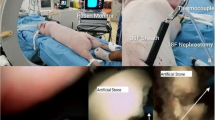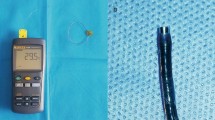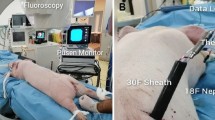Abstract
Purpose
To investigate the effect of prolonged laser activation on irrigation fluid temperature by varying the power settings flow rate (10–30 ml/min).
Materials and methods
An experimental study using a 20 ml syringe, 12/14 ureteral access sheath, a dual-lumen catheter and a thermocouple was performed. The laser was fired with 12 W (0.3 J × 40 Hz), 40 W (1 J × 40 Hz), 60 W (1.5 J × 40 Hz) using Quanta Ho 150 W (Quanta System, Samarate, Italy). All trials were performed with fluid outflow rate of 10, 20 and 30 ml/min with the fixed fluid volume at 10 ml.
Results
Continuous laser activation for 10 min with the outflow rate of 10 ml/min using only 12 W resulted to continuous temperature rise to as high as 83 °C. Similar rise of temperatures were observed for 40 W and 60 W with 10 ml/min outflow rate with intermittent laser activation. With 20 and 30 ml/min outflow rates the maximum temperatures for all power settings were below the threshold (< 43 °C). However, the time to reach the same total emitted energy was 60% and 40% shorter 60 W and 40 W, respectively.
Conclusion
Our study found that continuous laser activation with as less as 12 W using 10 ml/min outflow rate increased the irrigation fluid temperature above the threshold only after 1 min. In the current experimental setup, with the fluid outflow rate of 20 and 30 ml/min safe laser activation with 60 W and 40 W (temperature < 43 °C) can be achieved reaching the same total emitted energy as with 12 W in significantly shorter time period.



Similar content being viewed by others
References
Matlaga BR, Chew B, Eisner B, Humphreys M, Knudsen B, Krambeck A, Lange D, Lipkin M, Miller NL, Monga M, Pais V, Sur RL, Shah O (2018) Ureteroscopic laser lithotripsy: a review of dusting vs fragmentation with extraction. J Endourol 32(1):1–6. https://doi.org/10.1089/end.2017.0641
Aldoukhi AH, Ghani KR, Hall TL, Roberts WW (2017) Thermal response to high-power holmium laser lithotripsy. J Endourol 31(12):1308–1312. https://doi.org/10.1089/end.2017.0679
Aldoukhi AH, Hall TL, Ghani KR, Maxwell AD, MacConaghy B, Roberts WW (2018) Caliceal fluid temperature during high-power holmium laser lithotripsy in an in vivo porcine model. J Endourol 32(8):724–729. https://doi.org/10.1089/end.2018.0395
Maxwell AD, MacConaghy B, Harper JD, Aldoukhi AH, Hall TL, Roberts WW (2019) Simulation of laser lithotripsy-induced heating in the urinary tract. J Endourol 33(2):113–119. https://doi.org/10.1089/end.2018.0485
Taratkin M, Laukhtina E, Singla N, Kozlov V, Abdusalamov A, Ali S, Gabdullina S, Alekseeva T, Enikeev D (2020) Temperature changes during laser lithotripsy with Ho:YAG laser and novel Tm-fiber laser: a comparative in-vitro study. World J Urol 38(12):3261–3266. https://doi.org/10.1007/s00345-020-03122-1
Wollin DA, Carlos EC, Tom WR, Simmons WN, Preminger GM, Lipkin ME (2018) Effect of laser settings and irrigation rates on ureteral temperature during holmium laser lithotripsy, an in vitro model. J Endourol 32(1):59–63. https://doi.org/10.1089/end.2017.0658
Aldoukhi AH, Dau JJ, Majdalany SE, Hall TL, Ghani KR, Hollingsworth JM, Ambani SN, Dauw CA, Roberts WW (2021) Patterns of laser activation during ureteroscopic lithotripsy: effects on caliceal fluid temperature and thermal dose. J Endourol 35(8):1217–1222. https://doi.org/10.1089/end.2020.1067
Sapareto SA, Dewey WC (1984) Thermal dose determination in cancer therapy. Int J Radiat Oncol Biol Phys 10(6):787–800. https://doi.org/10.1016/0360-3016(84)90379-1
Turk C, Petrik A, Sarica K, Seitz C, Skolarikos A, Straub M, Knoll T (2016) EAU guidelines on diagnosis and conservative management of urolithiasis. Eur Urol 69(3):468–474. https://doi.org/10.1016/j.eururo.2015.07.040
Barone B, Crocetto F, Vitale R, Di Domenico D, Caputo V, Romano F, De Luca L, Bada M, Imbimbo C, Prezioso D (2020) Retrograde intra renal surgery versus percutaneous nephrolithotomy for renal stones >2 cm. A systematic review and meta-analysis. Minerva urologica e nefrologica = The Italian journal of urology and nephrology 72(4):441–450. https://doi.org/10.23736/S0393-2249.20.03721-2
Ho A, Sarmah P, Bres-Niewada E, Somani BK (2017) Ureteroscopy for stone disease: expanding roles in the modern era. Central Eur J Urol 70(2):175–178. https://doi.org/10.5173/ceju.2017.1343
Ventimiglia E, Pauchard F, Quadrini F, Sindhubodee S, Kamkoum H, Jimenez Godinez A, Doizi S, Traxer O (2021) High- and low-power laser lithotripsy achieves similar results: a systematic review and meta-analysis of available clinical series. J Endourol 35(8):1146–1152. https://doi.org/10.1089/end.2020.0090
Pietropaolo A, Hughes T, Mani M, Somani B (2021) Outcomes of ureteroscopy and laser stone fragmentation (URSL) for kidney stone disease (KSD): comparative cohort study using MOSES technology 60 W laser system versus regular holmium 20 W laser. J Clin Med. https://doi.org/10.3390/jcm10132742
Winship B, Wollin D, Carlos E, Peters C, Li J, Terry R, Boydston K, Preminger GM, Lipkin ME (2019) The rise and fall of high temperatures during ureteroscopic holmium laser lithotripsy. J Endourol 33(10):794–799. https://doi.org/10.1089/end.2019.0084
Aldoukhi AH, Black KM, Hall TL, Ghani KR, Maxwell AD, MacConaghy B, Roberts WW (2020) Defining thermally safe laser lithotripsy power and irrigation parameters. In vitro model. J Endourol 34(1):76–81. https://doi.org/10.1089/end.2019.0499
Liang H, Liang L, Yu Y, Huang B, Chen J, Wang C, Zhu Z, Liang X (2020) Thermal effect of holmium laser during ureteroscopic lithotripsy. BMC Urol 20(1):69. https://doi.org/10.1186/s12894-020-00639-w
Dau JJ, Hall TL, Maxwell AD, Ghani KR, Roberts WW (2021) Effect of chilled irrigation on caliceal fluid temperature and time to thermal injury threshold during laser lithotripsy. In vitro model. J Endourol 35(5):700–705. https://doi.org/10.1089/end.2020.0896
Rezakahn Khajeh N, Hall TL, Ghani KR, Roberts WW (2021) Pelvicaliceal volume and fluid temperature elevation during laser lithotripsy. J Endourol. https://doi.org/10.1089/end.2021.0383
Noureldin YA, Farsari E, Ntasiotis P, Adamou C, Vagionis A, Vrettos T, Liatsikos EN, Kallidonis P (2021) Effects of irrigation parameters and access sheath size on the intra-renal temperature during flexible ureteroscopy with a high-power laser. World J Urol 39(4):1257–1262. https://doi.org/10.1007/s00345-020-03287-9
Doizi S (2021) Intrarenal pressure: what is acceptable for flexible ureteroscopy and percutaneous nephrolithotomy? Eur Urol Focus 7(1):31–33. https://doi.org/10.1016/j.euf.2021.01.010
Author information
Authors and Affiliations
Contributions
AT: project development, data collection and analysis, manuscript writing. AP: data analysis and manuscript writing. LP: data collection, manuscript editing. EF: data interpretation. KP: data collection, manuscript editing. CA: data collection, manuscript editing. AV: data collection, manuscript editing. AN: data collection, manuscript editing. EL: project development, manuscript editing. PK: project development, manuscript editing.
Corresponding author
Ethics declarations
Conflict of interest
There is no financial support or funding, and there is no conflict of interest.
Ethical approval
No ethical approval was required for performing the current study.
Additional information
Publisher's Note
Springer Nature remains neutral with regard to jurisdictional claims in published maps and institutional affiliations.
Rights and permissions
About this article
Cite this article
Tsaturyan, A., Peteinaris, A., Pantazis, L. et al. The effect of prolonged laser activation on irrigation fluid temperature: an in vitro experimental study. World J Urol 40, 1873–1878 (2022). https://doi.org/10.1007/s00345-022-04000-8
Received:
Accepted:
Published:
Issue Date:
DOI: https://doi.org/10.1007/s00345-022-04000-8




